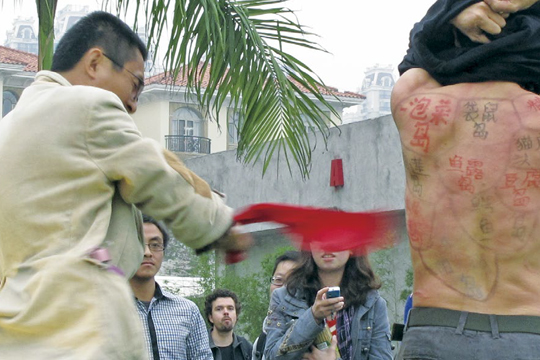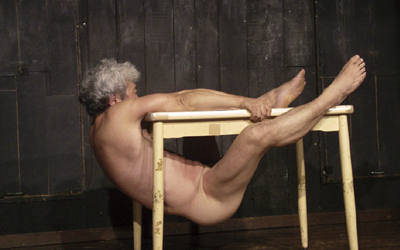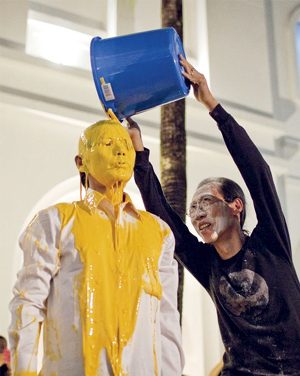TO SPEAK OF CHINESE PERFORMANCE ART AT A CROSSROADS: EASIER SAID THAN DONE
| July 16, 2013 | Post In LEAP 21

Ten years ago, when we talked about Chinese performance art, one would typically refer to controversial actions like eating a fetus. However, one should not forget that there were also Xiamen Dada’s burning of artworks after exhibition (1986), Xiao Lu and Tang Song’s shooting incident at the “China Modern Art Exhibition” (1989), the Beijing East Village artists’ To Add One Meter to An Anonymous Mountain (1994), and so on. Artists use their bodies as an immediate medium to present works that challenge the artistic and social norms of their times. “Performance art” was imported into the Chinese context in the early 1980s. With the dramatic rise of Chinese art in the international art market, works such as Zhu Yu’s Cannibalism (2000) in particular attracted much international and local debate. Popular views that performance art is not art, or that performance art is just antics, shunned the already peripheral practice to even further out on the fringes.
While attention is given to misplaced ethical controversy, performance artists have quietly shifted to a new mode of production and presentation, finding connections to other realms of artistic form.
PERFORMANCE ART FESTIVALS: SELF-ISOLATED OR SIMPLY NARCISSISTIC?
IN 1999, ART IST Ma Liuming invited Seiji Shimoda, artist and founder of Nippon International Performance Art Festival (NIPAF), to participate at an exchange event in Beijing. Shimoda’s visit in 1999 inspired Chen Jin, Zhu Ming, and Shu Yang to organize the first edition of OPEN Performance Art Festival in the Beijing suburb West Siduhe Village, Huairou. Participants included both local and international artists. Performance art festivals then usually ran for several days or one to two weeks, during which artists engaged in an intensive period of creating and presenting their work to one another. This model was enthusiastically introduced by Shimoda to Asia. His work On the Table had garnered much attention in Europe and America, and his experience at a Polish art festival had inspired him to launch the highly influential NIPAF in 1993. Many NIPAF participants had returned to their countries and organized similar events. This ripple effect reached China, too. Other than artist-led events, festivals provided performance a dedicated showcase, so that it need no longer be merely an add-on event in gallery exhibitions, or mere artifacts on conventional display.
The growing live art scene in the UK propelled Shu Yang and his fellow artists to organize the first Dadao Live Festival in 2003, Beijing. In the following years, art festivals and performances mushroomed in Xi’an, Chengdu, Changsha, and other cities in the Mainland. These departed from the standard curatorial model. Most of them were artist-run events determined by the artist-organizer’s aesthetic sense and personal social networks. Oftentimes artists would invite one another to participate in each other’s events. In recent years, the art festival boom has subsided due to the difficulty in sustaining harmony among organizers. Artist groups often reached irreconcilable differences in opinions. The legacy of Dadao Festival quietly ended in a gradual loss of vigor. OPEN also shifted towards organizing low-key, small-scale events after its climatic tenth anniversary in 2009. OPEN 10 involved an eight-week marathon presentation of 300 local and international performance artists.
Unlike painting, sculpture, and other traditional media, performance art does not easily circulate in the art market. Aesthetic exploration of performance art often comes with challenges to existing norms and taboos, and therefore artists are either self-exiled or repelled by the establishment. For years, its underground and sometimes illegal status has made festival resources scarce and the potential for sustainability slim.

Courtesy of wen yau
Performance art emphasizes live experience; the work begins when the artist is present. This makes performance art a practice that stresses human experience and the embodiment of subjectivity. The enactment of a performance depends heavily on factors such as space and audience. As the artist summons forth his/her own body, the work often communicates strong personal visions of society and the world at large. The inexpensive use of body as a medium also makes performance art a readily available platform for free experimentation, especially for artists working in developing countries. At the same time, the affecting interaction with the audience—which is always instantaneous and direct—makes performance art a useful tool for social and political protests. In the Mainland, such unpredictability of performance art often attracts police attention and censorship. Presentations involving nudity and social or political content invite investigation. The crowd for performance art festivals has typically consisted of artists, art audiences, and undercover cops. Artists often present their work that contains political messages tacitly along the blurry baseline of censorship under police surveillance.
As the tide of self-organized international performance art festivals subsided in China, Swedish curator Jonas Stampe has been organizing the annual festival Guangzhou Live since 2010, showing a new kind of cultural imagery in the field. In his festivals during the past three years, more European artists are presented than Chinese performance artists. The curator-led model of organizing such an unfettered and subjective art form as performance art brings along issues about presentation and censorship with performance artists.
In the first iteration of Guangzhou Live in 2010, Vietnamese artist Tran Luong was interrupted by the curator in the middle of his performance, whereas other participating artists were warned against involving politically overt content in their work. This involves not only issues about subjectivity and objectivity, or cultural differences and cultural politics, but also the boundary of performance art practice in China. Should art be censored, and by whom? How to censor it? These questions about art are particularly pertinent for performance art, which emphasizes autonomy and the live experience. Should performance art continue to uphold its solitary narcissistic tendencies, seek ways to enter the mainstream, or hover in between?
“CHINESE PERFORMANCE ART”?
This reminds me of the Macao Art Museum’s “Inward Gazes: Documentaries of Chinese Performance Art,” of which the third edition presented last year organized a symposium regarding the present state of Chinese performance art. As a commentator I felt compelled to retort, what exactly do you mean by “Chinese?”
The organizers of “Inward Gazes” have held an open call submission for Chinese performance art every three years. Artists submit documentation of past work, and the jury selects outstanding and awarded works that a museum will present in the triannial exhibition and acquire for their collection. So far, the first two editions of this competition named winners that were subsequently invited to participate in a festival in France and show their work at the Macao Pavilion in the Venice Biennale. “Inward Gazes” is the first formal presentation of performance art by an official museum in China. Its open call process proves an effective model of developing its museum collection of performance work on a periodic basis.
For the moment, we need not discuss the limitations of using the competition model to present performance art, seeing as how the medium stresses the live aspect. Over the years the more heavily debated issue has revolved around the organizer’s definition of “China” in its invocation of “Chinese performance art.” The exhibition categorizes each participating artist by geography: “Four Cross-Strait Regions,” “Chinese citizen,” and “Overseas Chinese.” (1) Yet from the perspective of modern history, there are countless and often contradictory ways of tracing the definition of China. The general category of “Four Cross-Strait Regions” involves a variety of cities and cultures that identify with China in different ways. Performance art from each region has via its own context developed in different ways. Taiwanese artists, for example, may refuse participation in this competition due to political considerations and problems of identity. Likewise, many Hong Kong artists waver in their uncertain relationship with “Chinese” performance art” (2).
For a long time, performance art as an ephemeral art form positioned itself at the periphery of the art system. Lacking a mature discourse and substantial research, performance artists easily fall into idiosyncratic language. While “Inward Gazes” offers a method of building performance art museum collections, the museum must also explore ways of building relevant discourse by organizing research, literature, and historical documentation. The notion of archiving Chinese performance art within such a generalized cultural imagery, however, seems to work against the rebellious nature of an art medium that develops via a nonlinear network. If documenting performance art already triggers so much debate, how can we explore the possibilities of its assimilation into mainstream art infrastructures?
SURVIVING BETWEEN THE GAPS OF THE SYSTEM
To preserve a field of rebellious freedom, many performance artists refuse to enter the mainstream art system by rejecting sponsorship and market values. Strategic adoption of art-world structures may not necessarily mean trading away their critical position of freedom. Many universities in Europe and America now offer performance art courses, and there are dedicated institutions as well. Franklin Furnace Archive is an experimental site active since the 1970s. Aimed to “make the world safe for avant-garde art,” the Archive has presented the work of many notable artists, including John Cage, Laurie Anderson, and Vito Acconci. The Archive settles itself outside the mainstream system and shows its mission in a humble yet dignified way.

Courtesy of Lee Wen
Live Art Development Agency is another such example with an open attitude towards diverse art performances. Founded in 1999, the Agency provides support for professional development, presents research projects and publications, and hosts a study room, cultural exchange programs, and so on. The Agency offers institutional support to experimental performance practice by building sustainable infrastructure and developing its own discourse. This may be another strategy for co-existing with the establishment.
On the other hand, performance art is slowly entering into museum programs. In 2009 MoMA expanded its media art department to include performance art (3). In 2010 the museum presented Marina Abramović’s “The Artist is Present,” for which over a two-month period the artist sat motionless for more than 700 hours, inviting audience members to sit across from her one at a time. This event became the talk of the town while the museum celebrated a record attendance of 500,000 visitors. “The Artist is Present” offered a direct and sensual experience that transformed the white cube into a participatory public space. The contemporary art world was suddenly again impressed by performance art. Last year, Tate Modern also hosted a series of performance art events and exhibitions to launch its new Tanks. In Asia, the Singapore government lifted its ten-year ban against government sponsorship of performance art in 2003 (4). Performance art seems to be more institutionalized, as the Singapore Art Museum (SAM ) organized two consecutive retrospectives of local artists Amenda Heng and Lee Wen, who actively practice performance art, in 2011 and 2012 respectively. How to showcase avant-garde art in the institutional sanctum? How do the artwork and the exhibition space relate and adapt to each other? How can presentation produce meaning and impetus for contemporary discourse? Perhaps these questions offer the potential to resolve the complexity of cultural negotiation.
The notion of alternative vis-à-vis the mainstream may sound too simplistic. Given that performance art is said to have sought alternative ways of presentation within established art systems, America and Europe have seen particularly well-developed platforms for performance art to bloom in between the gaps. Archiving performance art has also advanced past the foundational goals of keeping and compiling historical information. Responding to the temporal nature of the medium, performance artists work towards creating documentation that displays old works through reenactment. Meanwhile, performance studies are growing in popularity, bringing the form into a wider cultural, social, and political context by way of the cross-disciplinary. In recent years young academicians have successively published PhD theses on “Chinese Performance Art.” Last year The Sichuan Art Academy also formally introduced coursework on performance art. How will these changes affect the new generation of performance artists? While global art discourse continues its interest in politically and socially engaged practice, and Chinese art retreats from its bubble years, Chinese performance art continues to struggle between being solitary and being institutionalized. Trapped between local, regional, and international platforms, how will performance art maintain its particular legacy? At these crossroads, we have yet to see any new developments.
Notes:
1. The first open call competition in 2005 invited “Four Cross-Strait Chinese artists residing in Mainland China, Hong Kong, Macau, and Taiwan;”; the second open call in 2008 invited “Four Cross-Strait Chinese artists”; and the third in 2012, “Four Cross-Strait Chinese citizens and overseas Chinese.”
2. In this article, “Chinese performance art” refers generally to performance art practice in Mainland China.
3. In 2009, MoMA renamed its Media Arts Department the Department of Media and Performance Art.
4. In December 1993, Josef Ng and other artists engaged in a performance of drinking urine, trimming pubic hair, and engaging in homosexual behavior. The Singaporean government subsequently terminated its sponsorship of performance art and related theater and discussion, claiming that the unscripted and spontaneous acts will endanger public order and security, and promote abnormal information regarding society and religions.

